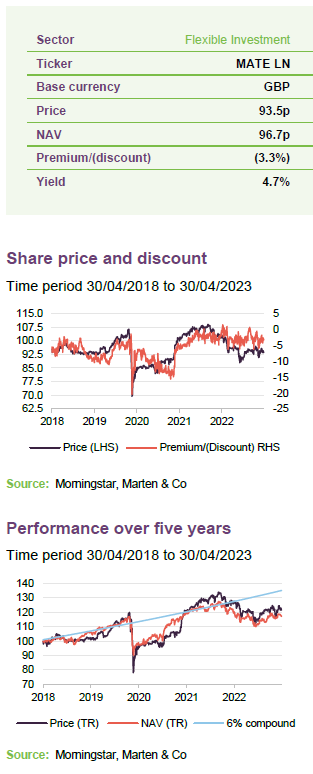JPMorgan Multi-Asset Growth & Income
Investment companies | Annual overview | 2 May 2023
Caution in the face of volatile markets
In a world of volatile equity markets and uncertain futures, MATE offers investors a straightforward target of achieving an average of 6% compound annual returns over a rolling five-year period and paying an inflation-linked dividend.
MATE has now passed its five-year anniversary, and its life has been marked by two of the worst bear markets in recent memory. In the grip of a painful downturn, MATE has fallen short of its target return. The team has not chased risk in an attempt to catch up, as MATE still has half the risk of the global equity market, based on its standard deviation.
MATE’s commitment to providing growing income, is supported by its revised dividend policy. Its combination of target long-term returns and growing income remains its defining feature, and one which may set it apart from its peers. MATE has also been able to sustain a narrow discount throughout 2022, currently trading on 3.3% discount.
Income and capital growth from a multi-asset portfolio
MATE aims to generate income and capital growth, while seeking to maintain lower levels of portfolio volatility than a traditional equity portfolio. It operates a multi-asset strategy, maintaining a high degree of flexibility with respect to asset class, geography and sector of the investments selected for the portfolio.

What makes MATE your mate?
Targeting 6% compound annual returns and lower volatility than equities.
MATE is a multi-asset vehicle, targeting total returns of 6% on average per year over rolling five-year periods. MATE is designed for those investors who are looking for what could be considered an attractive, relatively-predictable income that grows at least in line with inflation.
MATE’s board feels that achieving the income objective ought not to come at the expense of investors’ total returns. Consequently, the manager, JPMorgan Asset Management (JPMAM), has the freedom to invest with the aim of maximising total returns rather than chasing revenue. To meet the target objective, MATE’s investment management team has created a diversified portfolio, aimed to exhibit volatility two-thirds the volatility of that of a global equity index. This is a profile that may be attractive to the more cautious investor with a long-term time horizon.
Why multi-asset?
Multi-asset portfolios can be less volatile than pure equity portfolios.
MATE offers investors a strategy that captures a number of different types of asset classes, be it fixed income, infrastructure, or equities, across multiple regions and issuers. This is important because true diversification requires multiple, uncorrelated asset classes, so that (in theory) no two asset types fall in tandem. This may smooth out the investment journey for shareholders over the last five years, potentially achieving a given expected return for a lower volatility relative to global equity markets.

Figure 1 shows the correlations between the different asset classes (as represented by the indices listed in the notes to Figure 1) that the manager expects to have exposure to over a market cycle.
Looking over a wider sample period, since March 2019, MATE has been able to offer an average correlation of 0.74 to global equities, as well as an on-average negative correlation to global bonds.

At the outset, MATE’s managers devised a strategic asset allocation (SAA) for the fund that was designed to capture an asset class mix that would help them achieve their overall objectives over the long term. This was informed by JPMorgan’s long-term capital market assumptions (looking 10–15 years out) and the correlations between these different asset classes. There is no requirement for the portfolio to have exposure to all of the core asset classes that make up the SAA.
The managers have freedom to deviate from the SAA.
The managers’ hands are not tied by the SAA and they have the have the freedom to deviate from the SAA and make opportunistic investments, e.g. to capitalise on short-term market conditions. MATE may also invest in alternative assets and currently holds exposure to infrastructure, for example. An important constraint on exposure to alternative assets is liquidity.
The SAA is unchanged since launch and the asset class split is shown in Figure 4.

Figure 5 charts the returns from a portfolio of 100% developed market equities versus the return on a portfolio constructed in line with the SAA. Over this five-year period, the equity index outperforms. However, as the figures in the table show, in times of equity market stress, the SAA portfolio holds up much better.

Fund profile
More information is available at the company’s website http://www.jpmmultiassetgrowthandincome.com.
MATE aims to provide a cost-effective (i.e. competitive fees) investment vehicle for investors who seek income generation and capital growth from a multi-asset strategy while maintaining a high degree of flexibility.
Its managers seek to achieve the best risk-adjusted returns (with lower levels of volatility than a traditional equity portfolio) by investing in a globally diversified portfolio that includes company shares, bonds and other assets, like infrastructure. Their aim is to construct a well-balanced portfolio which is flexible with respect to asset class and geography. This flexibility should allow them to take advantage of the best opportunities to deliver an attractive total return to shareholders.
Simple 6% compound return objective.
Since its IPO in 2018, MATE’s objective has evolved subtly. Having launched with a requirement to pay a covered dividend, the board subsequently believed it could be too restrictive on the investment managers. It also scrapped the benchmark of LIBOR+4.5% for the current target return of 6% per annum, measured over a rolling five-year period, which gives the added simplicity of a clear, non-fluctuating target.
The managers believe that the return is achievable based on JPMorgan’s long-term return assumptions, which inform the company’s strategic asset allocation (see page 10) and the additional alpha achievable from active positioning both bottom up and top down.
Future dividends to grow at least in-line with inflation.
MATE is now able to fund its dividend from its capital account, but still retains the same original dividend objective, which aims to increase the dividend in line with the UK’s annual Consumer Price Index (CPI) from the initial distribution level of 4p per share per annum set at launch in 2018.
The greater investment flexibility afforded by the refined objective allows the managers to invest in lower-yielding but potentially attractive total return strategies.
Management arrangements
JPMorgan Funds Limited (JPMF) acts as MATE’s AIFM and company secretary. JPMF delegates the management of the portfolio to JPMorgan Asset Management (UK) Limited (JPMAM).
The lead investment managers – Katy Thorneycroft and Gareth Witcomb – have over 35 years’ combined experience.
The lead investment managers responsible for MATE’s portfolio are Katy Thorneycroft and Gareth Witcomb, who have a combined experience of over 35 years in the asset management industry (see page 20). They are members of JPMorgan Asset Management’s Multi-Assets Solutions Team, which consists of over 80 investment professionals located across the globe, managing assets of over $304bn as at 30 June 2021. They can draw on the resources of over 1,200 investment professionals and access a platform of over 500 managers.
The wider JPMorgan Asset Management business is one of the world’s largest, managing over $2.5trn on that date. JPMorgan Asset Management also manages 20 investment trusts across a diverse range of geographies and asset classes.
Macroeconomic update
Since our last note, published in August 2022, economic markets have once again taken investors on a roller-coaster. However, unlike the first three quarters of 2022, there has been some upside since mid-October.
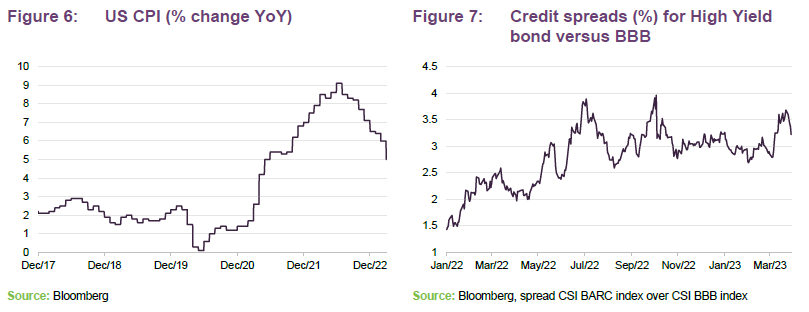
The top-level summary is that markets have largely demonstrated the same driving factors as they did in our last note, bar a handful of developments, with inflationary pressures possibly being the overwhelming headwind facing investors. However, thanks to some positive economic data from the US, falling energy prices, and China’s economic reopening, the outlook for the global economy is arguably rosier than it was when we wrote our previous note.
Inflation has been falling in the US, with some pundits arguing we are now past the ‘inflation peak’, with the rate of growth in US prices now far lower than the level of our last note. There is still considerable uncertainty, however, as the Federal Reserve remains hawkish, with concerns around the ‘stubbornness’ of core US inflation, a sentiment shared by the JPMorgan Multi Asset Team.
The tapering of inflation expectations seems to have done little to reduce the risk on US high yield debt. As can be seen in Figure 7, the spread on high-yield corporate bonds over investment grade, while off its highs, remains elevated relative to end-2021. A higher interest rate environment coupled with possible economic malaise, has meant that lower-quality credit issuers are being placed under greater scrutiny.
One driver for the mellowing of global inflation has been the collapse of energy prices, especially natural gas. The likely reason for this is that the world has acclimatised to the realities of the Ukrainian war, which has just passed its first anniversary. With major economies having had to adjust their energy markets to account for the absence of Russian gas, for now at least, energy prices have fallen. This may allow Europe to avoid a deep recession, which seemed a possibility when we published our last note.

We find a bullish sentiment on the other side of the Pacific, thanks to China’s economic reopening. Its once-stringent anti-pandemic measures have been rapidly unwound, potentially unleashing years of pent-up demand from the world’s second-largest economy. While reliable Chinese economic data can be sparse, what is available points to a rebound both consumer and market sentiment, with Chinese PMI moving above 50 for the first time since July 2022.
It may be that China can once again return to being the engine for global GDP growth, offsetting more muted growth elsewhere. However, a relatively modest GDP growth target of 5% for 2023, as the government promises to prioritise economic stability, appears to have undermined the recovery in its equity market. Despite the rebound, investors in China still need to grapple with the country’s mercurial politics, painful geopolitical risks, and the economy’s sensitivity to global demand, given its role as a global exporter.
Managers’ macroeconomic views
JPMorgan’s Global Multi Asset Team includes economists, market strategists, and quantitative research analysts. The Multi-Asset Solutions’ asset allocation views are the product of a rigorous and disciplined process that integrates qualitative insights and quantitative analysis from dedicated research teams together with ongoing dialogue between investment and research teams.
Figure 11 shows the team’s views on various asset classes for Q2 2023.

The team has recently published the conclusions of its latest Strategy Summit, a quarterly forum for debate, challenge and formulation of the firm’s asset allocation views. Both its outlook and positioning are cautious. In summary, it suggests that recent banking stresses imply tighter bank lending standards ahead which could further slow growth in developed economies. Recession risks have increased, and the team believes that 2023 is set to be a year of sub-trend and disappointing growth. However, with little evidence of extreme excess in the real economy and with better capitalised banks, it believes that a repeat of 2008 is unlikely. Should commercial banks tighten lending standards, the Federal Reserve and other central banks will need to do less to bring about the desired slowdown in activity and reduction in inflation. At this stage, it believes that the considerable uncertainties over the extent to which the recent turmoil will affect sentiment and activity, argue against extreme positioning between or within asset classes.
The team continues to lean away from US stocks, given growth risks are most elevated in this region as rates have moved sharply higher and credit conditions are likely to get a lot tighter which will prove a headwind for growth. The team acknowledges the resilience of the European market – which has benefited from the fall in energy prices – and feels that in China, there are signs that pent-up demand and savings accumulated through the COVID years can support activity in the reopened Chinese economy. However, with risks skewed to the downside, the team is comfortable maintaining lower levels of equity exposure overall.
The team has become more positive on duration this year as it offers a higher yield and more protection against a market correction as investors’ and central bankers’ attention has shifted from inflation to growth. Overall weighted duration has increased by almost two years relative to the position at the end of November, with much of the exposure being held in longer dated US government bonds, where the team has been adding opportunistically as yields have backed up. It notes that historically, the end of a Fed hiking cycle has often coincided with improved returns from US treasuries. In contrast, the team is less positive on Japanese bond markets and has a short position, as it believes that the BoJ will bring an end to yield curve control. The team added a small position in investment grade corporate bonds and also emerging market debt this year, where it sees the potential for relative value opportunities in local currency markets. The flexibility afforded by the trust will enable it to add further to positions as conviction in these asset classes increases.
Following the sharp declines in both equity and fixed income markets last year, driven by worries around inflation and how the central banks would take action to tackle this, traditional correlations broke down, but the team notes that high-frequency measures are showing an improvement in correlations this year, which should be beneficial for portfolio performance. Infrastructure offered some diversification benefit through the turmoil of last year, and the team may look to other alternatives strategies to complement this exposure.
Investment process
MATE’s investment team can add value by getting their asset allocation right relative to the SAA and selecting high conviction, strategies. The top-down quantitative and qualitative research produced by the Global Multi-Asset Strategy Team therefore forms a key part of the investment process.
SAA unchanged since launch.
No changes have been made to the SAA since MATE was launched, but it is revisited annually. The removal of the requirement to cover the dividend has given the managers greater flexibility and increased the range of strategies available to MATE.
Global equities in a directly-invested portfolio.
Typically, asset classes are accessed through funds, except for global equities, which are managed as a directly-invested portfolio. Within those funds or the equity portfolio, the underlying managers have full responsibility for their bottom-up investment selection, and that includes decisions relating to industrial sector and geographic exposures.
The portfolio is monitored and managed within the framework of a formal cycle of meetings.
- Macroeconomic strategy is revisited quarterly. A formal, quarterly strategy summit helps to set the broad research agenda and determine the intermediate multi-asset strategy asset allocation view.
- Monthly portfolio construction meetings will typically trigger changes to the portfolio. Changes to the portfolio are usually made gradually.
- However, the portfolio managers also attend daily meetings which capture significant developments and facilitate a discussion of event risks.
MATE may invest in funds managed by external managers.
The next element of the investment process is evaluating and selecting investment teams, primarily selecting strategies from across the JPMorgan Asset Management platform, but also accessing third party investment trust managers where appropriate, for example, the portfolio currently has a small allocation to 3i infrastructure.
The managers adjust MATE’s overall market exposure and regional asset allocation either through selling physical assets or by using equity index futures and bond futures.
Risk management is an integral, ongoing and critical part of the managers’ investment process.
Risk management is an integral, ongoing and critical part of the managers’ investment process. They believe that risk is a necessary component of active investment management, and that it can be estimated, measured and managed.
The lead managers monitor a range of aspects such as performance, portfolio diversification and the potential impact of proposed portfolio changes.
A risk team, embedded within the Multi-Asset Solutions Team, monitors a broad range of ex-ante risks and market sensitivities; stress tests against market scenarios and asset price shocks; and monitors risk concentrations both within MATE’s portfolio and across all portfolios.
An independent risk management team monitors trading and portfolios across the manager’s business, looking at aspects such as Value at Risk (VaR).
Examples of quantitative factors that the managers take into consideration include the correlations between strategies, downside risk and consistency of performance. In addition, face-to-face meetings with the managers and investment teams responsible for the different parts of the portfolio allow the lead managers to clarify more qualitative factors such as the stability of investment process, stability of investment team and risk measurement.
ESG
ESG is integrated into the investment process across all asset classes.
The multi-asset solutions team believes that financially material ESG factors may impact risk/return characteristics of the underlying managers/strategies in which it invests. Therefore, it looks to understand if the underlying managers/strategies are adequately identifying and actively mitigating risks and seeking opportunities, where they believe they are material to their investment process.
To become ESG integrated, each investment team on the JPMAM investment platform has been vetted by its centralised sustainable investing team. The team comprises senior portfolio managers, research analysts and investment stewardship specialists across the firm, who define and oversee the ESG integration process for investment desk.
Within the manager/strategy evaluation process, it focuses on understanding how ESG considerations influence the capabilities of the underlying manager/strategy and the investment process. The emphasis is on understanding how ESG factors are considered and how the manager/strategy defines, evaluates, and rationalises the inclusion of securities that may score poorly and/or contain perceived headline risk. Multi-asset strategy portfolio managers consider this information, among other variables, when reviewing managers/strategies within the overall portfolio construction process. At investment director quarterly meetings, ESG characteristics can be challenged and discussed.
For external managers, the portfolio management team assesses ESG characteristics prior to investing through engagement with the manager and third-party brokers. A considerable amount of the ESG analysis is done via the bottom-up process of the underlying managers/strategies, which are assessing materiality within their respective investment processes and determining ESG factors at the issuer level.
Investment Restrictions
The company has the following investment restrictions at the time of investment, calculated on the company’s total assets:
- no individual investment may exceed 15%, with the exception of developed countries government bonds and funds;
- no single developed country government bond or fund will exceed 30%;
- for investment in funds, on a look-through basis, no individual investment may exceed 15%; and
- listed equities and fixed income securities will represent not less than 50%.
Derivatives and hedging
Whilst MATE has the ability to borrow money, in practice it has not done so. Instead, when they feel it is appropriate, the managers achieve leverage through the use of futures.
MATE’s managers use derivatives to seek to enhance portfolio returns and for efficient portfolio management, to reduce, transfer or eliminate risk in its investments, and to offset exposure to a specific market. For example, the current underweight duration in the bond element of the portfolio has been achieved by shorting long-dated government bonds.
MATE usually hedges developed market currency risk back to Sterling. However, they may, as part of the overall asset allocation process, decide to retain currency exposure as part of their investment strategy.

Asset allocation

Figure 13 shows how MATE’s actual asset allocation has changed since launch. As of 28 February 2023, MATE’s portfolio was 88% invested, with an overweight allocation to what could be considered ‘defensive assets’ relative to the SAA. However, the largest deviation remains the substantial cash position (hence the sub-100% market exposure), which MATE has held since June 2022, reflecting the increasing downside risk that plagued global markets since then. We note that cash is also used to ‘offset’ the derivatives held.

The position at end March 2023
As can be seen in Figure 16, MATE has large underweight exposures to developed market equities, high yield and emerging market debt, relative to the SAA, all of which (alongside emerging market equities) might be considered amongst the highest-risk assets MATE can invest in and those most exposed to rising inflation; a position in-line with the aforementioned macro views of the team. The largest increases within the overweight positions have been in emerging market equity and government bonds. Emerging markets are a region which may offer the most attractive equity outlook, thanks to China’s economic reopening, and lower inflation figures being printed by emerging market economies. The increase in MATE’s bond exposure coincides with the team’s increasingly positive outlook on duration, which signals a more bullish stance on bonds, with the team taking advantages of the increasingly attractive yields in US bonds, as well as some select corporates and emerging market issuers.
MATE’s cash position has fallen substantially since our last note, and reflects the team’s confidence in duration, as cash is effectively a zero-duration asset.
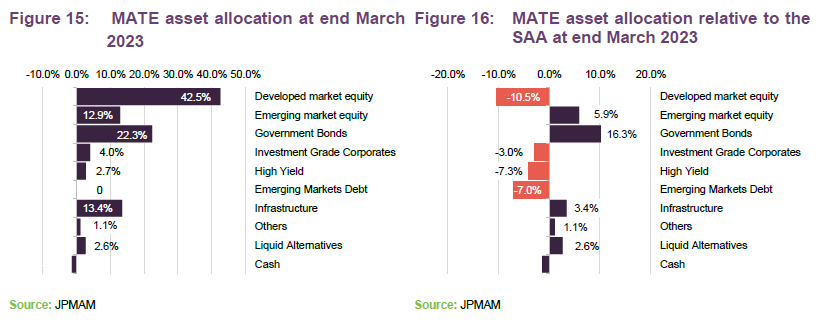
The 10-largest holdings

MATE’s largest holdings reflect the team’s macro-economic views and include the allocation to infrastructure through IIF and a holding in 3i Infrastructure.
Equity portfolio
Since we last published, using data as at the end of July 2022, the allocation to North American equities has fallen (from 70% of the equity portfolio to 54%) reflecting the team’s underweight stance on the region’s equity markets. The beneficiary of this reallocation has been the Europe ex UK region, where the percentage weighting has risen from 1% to 14%. The trust also has some exposure to the UK, where it had none previously. However, there has been little change in MATE’s equity sector allocations.
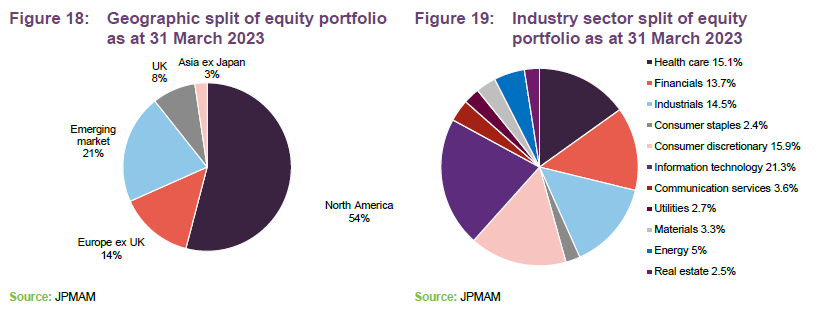
Top 10 equity positions
There have been a number of new additions in MATE’s top ten equity positions, reflecting both trading activity by the team and the relative strength of certain companies. The major shift however has come from the increased concentration of MATE’s top 10 equity holdings. New additions include the beverage maker Coca-Cola, the technology giant Apple, and the global payment provider Mastercard. These entrants replaced McDonalds, Progressive and Bristol-Myers Squibb, which were amongst MATE’s top 10 equity holdings in our last note.

Performance
MATE has now reached its five-year performance track record milestone, and over this period MATE has been able provide investors with compounding returns in excess of its 6% return target some 45% of the time (based rolling 12-month NAV returns, sampled over the last five years). With a five-year NAV return of 17.1%, MATE has currently underperformed its target return over this period, which would have generated 33.8% when compounded. We note that whilst five years is a common reference frame for investment strategies, the SAA team’s investment horizons are longer, preferring to think in terms of a 10–15-year period.
MATE’s underperformance may be related to the strategy being launched in advance to two of the most painful bear markets in recent memory, the COVID crash of 2020 and the inflationary downturn of 2022. This underperformance could be attributed to the fact that MATE primarily invests through bonds and equities. While these assets have historically shown weak correlation to each other, in both market downturns their correlation rapidly increased, with both asset classes being sold off in tandem. This may have been due to a widespread risk-off attitude, or due to both assets becoming increasingly susceptible to interest rate rises. MATE also missed out on the initial stages of the 2020 recovery – from an overabundance of caution by the managers. However, they redeemed themselves by being bolder with their asset allocation over the summer and autumn of 2020. Nevertheless, given the enormity of the recent downturns, and despite the best efforts of the team, a portfolio of predominantly bonds and equities would have found it very difficult to keep up with a positive return target.
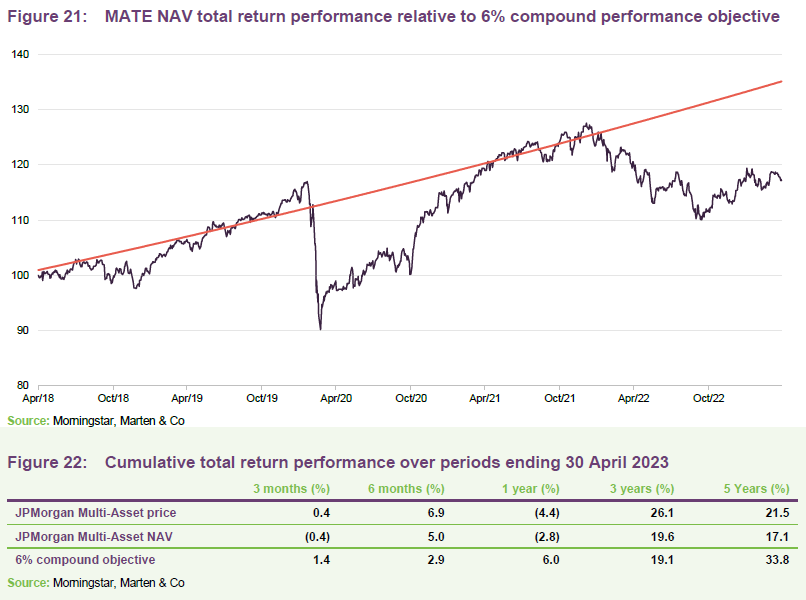
As we have noted in the past, MATE’s investment team had previously been constrained by the requirement to fund the dividend from MATE’s revenue account, which constrained the managers’ investment choices. The removal of the requirement to cover the dividend may allow the team to invest in lower-yielding but faster-growing investments.
MATE also operates with a volatility objective, aiming to meet its return objective with a volatility of half that of the MSCI World. MATE has met its volatility target, with a five-year standard deviation of 11%, half that of the 22% standard deviation of the MSCI ACWI.
Peer group
Up to date information on MATE and its peer group is available on the QuotedData website.
MATE is a constituent of the AIC’s Flexible Investment sector. These funds have investment objectives and/or policies that allow them to invest in a range of different asset types – multi-asset funds, therefore. However, this encompasses a wide variety of funds with very different performance objectives. The full AIC sector would most likely make a poor comparison for MATE.
The list of funds selected for Figures 23 and 24 excludes Caledonia Investments (a trust managed on behalf of a family), Hansa Investment Company (a family-controlled trust with a strong bias to Brazil), JPMorgan Core Real Assets (which has no equity exposure), JZ Capital Partners (a private equity fund that strayed into real estate with disastrous results), Livermore Investments (which has a strong bias to structured finance), Majedie Investments (which is a very recent addition to the sector and whose track record does not reflect a multi-asset approach, therefore), New Star Investment Trust (which is run largely for the benefit of ex-employees of New Star), RiverFort Global Opportunities (which provides financing to very small companies), Schroder BSC Social Impact (which aims to make investments that have a positive social impact), Tetragon Financial Group (which invests in a wide variety of alternative investments including an asset management business), and UIL (a split capital company with an eclectic portfolio).
Even this pared-down list encompasses quite a wide variety of investment styles and risk appetites. The closest comparator to MATE may be Aberdeen Diversified Income & Growth.

These strategies are managed to varying return objectives, with a wide variety of assets being held, with some being directly comparable conventional bond and equity portfolios, like MATE, and some investing in assets as exotic as crypto currency. There is also a disparity in the level of income generated by the peer group, as can be seen by Figure 23 few of MATE’s peers can provide an income comparable to MATE’s, if any level of income at all, which also complicates comparison. We include performance since strategy change for a more meaningful comparison in this regard, given MATE’s increased investment freedom. MATE also has one of the lowest risk profiles of its peers, as determined by the volatility of its share price returns.
MATE’s annualised standard deviation of returns since launch is almost half that of the MSCI World Index.
MATE is on the small side, being sub-£100m. MATE has tended to trade on a small discount, especially when compared to its peers, which may reflect a strong buyback policy from the board and also the combination of a straight-forward return target and attractive income. Despite its size, MATE’s ongoing charges ratio is competitive based on its ranking.
As can be seen from Figure 23, few of these funds offer attractive yields, and those that do tend to have lower long-term total returns. We do note that MATE’s near-term (six-month) performance has improved relative to its peers however, with the trust possibly being better placed to capitalise on the recent rally in equity markets than its peers.

Predictable, inflation-linked dividend
MATE’s current policy is to increase its dividends in line with inflation.
For the financial year that ended on 28 February 2023, the board stated an intention to pay a full year dividend of 4.4p per share, to be paid in quarterly instalments of 1.1p. This was 7.3% higher than the 4.1p paid for the accounting year ended 28 February 2022. At end February 2022, UK CPI was running at 6.2% year-on-year.
As at 28 February 2022, MATE’s most recent annual report, it had fully depleted its revenue reserve. This is a reflection of MATE’s relatively short life and the new policy that enabled the managers to invest in lower yielding assets. Under its new policy MATE has the ability to utilise distributable capital reserves to fund its dividend. MATE has reported a distributable special reserve of £84.8m, which reflect almost the entirety of the shareholders’ funds.

Premium/(discount)
Over the year ended 30 April 2023, MATE’s shares moved between trading at a 6.3% discount and a 1.5% premium and, on average, traded at a discount of 2.6%. On 28 April 2023, MATE was trading at a discount of 3.3%.
The board recognises that it is in the interests of shareholders to maintain a share price as close as possible to the NAV. It considers using buybacks to address imbalances in supply of and demand for MATE’s shares in the market, when it believes it is in the interests of all shareholders and subject to normal market conditions.
Shareholders have granted the board the authority to repurchase shares in the market either for cancellation or into treasury. Such repurchases are carried out at a price below NAV, thereby enhancing the NAV for ongoing shareholders. As is typical, the limit on the amount of shares that can be repurchased is 14.99% of the shares in circulation on the date of the last AGM.
The directors may also sell treasury shares or issue new ordinary shares at a premium to NAV. Here the authorised limit is 10% of the shares in circulation on the date of the last AGM.
As can be seen in Figure 26, MATE’s discount has recovered substantially from its pandemic lows, with the trust trading on a largely stable discount over the past 12 months, despite the wider market turmoil.
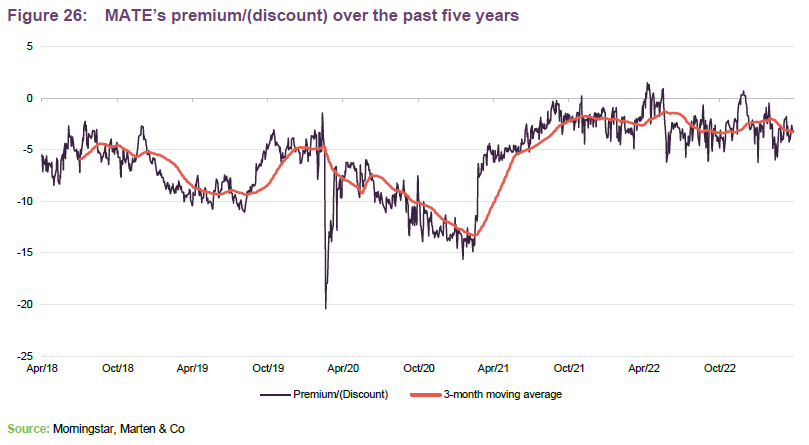
As Figure 27 shows, since March 2021 (immediately following the announcement of the changes to the objective), MATE has been repurchasing its shares on a fairly regular basis, to the benefit of a narrower discount, and – as shares are repurchased at a discount – the buybacks have been NAV-accretive for ongoing shareholders.
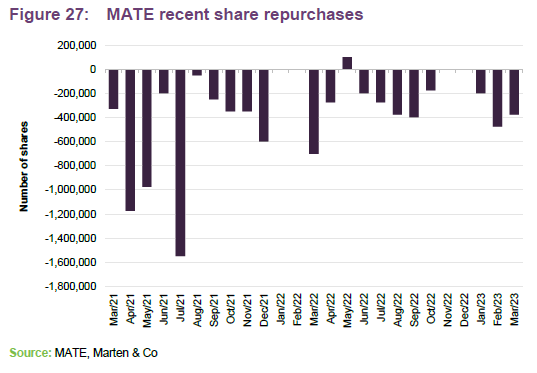
Fees and costs
MATE’s investment management fee is charged at the rate of 0.65% per year on the first £250m of NAV and 0.60% on the balance. No performance fee is payable at the company level, but the portfolio may be invested in funds that charge performance fees and these are not rebated. The management fee is calculated and paid monthly in arrears.
Where they are available, investments made through funds managed by J.P. Morgan Asset Management are in non-management-fee-bearing share classes. Where a non-management-fee-bearing share class is not available, the investment will be made through the lowest institutional-fee-bearing share class available and MATE’s investment management fee is reduced to offset these charges.
The investment management agreement is terminable by either party on six months’ notice or on shorter notice in certain circumstances.
All secretarial and administrative services are also provided by JPMF and the costs of these services are included in the management fee.
For the year ended 28 February 2022, administration expenses of £241,000 (FY21: £212,000) and directors’ fees of £119,000 (FY21: £120,000) made up the bulk of MATE’s other expenses.
MATE’s ongoing charges ratio, calculated for the year ended 28 February 2022, was 1.07% (FY20: 1.04%). The increasing ratio reflects the impact of fixed costs on a declining NAV.
Capital structure and life
MATE has ordinary shares and no other classes of share capital. At 31 March 2023, there were 93,115,643 ordinary shares in issue. 16,197,235 ordinary shares were held in treasury and therefore the number of shares in circulation and with voting rights was 76,918,408.
The company’s accounting year end is the end of February, and it usually holds its AGMs in June/July.
Gearing
MATE may use gearing, in the form of borrowings and derivatives, to seek to enhance returns over the long term. At present, the company has no bank loans/facilities or structured debt.
Borrowings may be in sterling or other currencies. Total borrowings will not exceed 20% of net asset value at the time of drawdown. Total net investment exposure, including derivative exposure, would not normally be expected to exceed 120% of NAV.
Continuation vote
Whilst MATE is designed to have an unlimited life, the directors will ask shareholders to vote on the continuation of the company at MATE’s fifth AGM, expected to be held later this year. Assuming that this is passed, subsequent continuation votes will be held at five-yearly intervals thereafter.
Managers
Katy Thorneycroft, managing director, leads Multi-Asset Solutions’ International Portfolio Management team, focusing on multi-strategy investing, including benchmark oriented, flexible and total return strategies, as well as funds of investment trusts. Katy has worked for what is now JPMAM since 1999, having previously been a portfolio manager in the convertible bonds team and a member of the Multi-Asset Solutions team in New York. Prior to this, she was a portfolio manager in the European Equity group in London focusing on small and mid-cap strategies. Katy has an M.Chem from the University of Oxford and is a CFA charterholder.
Gareth Witcomb, executive director, is a portfolio manager in the Multi-Asset Solutions team, based in London. He manages global balanced portfolios and flexible mandates, and participates in the asset allocation framework, where he specialises in providing fixed income insight. Gareth has previously worked on JPMAM’s macro strategies and alternative beta products as a portfolio manager. An employee since 1998, Gareth joined the Multi-Asset Solutions team in 2005. Gareth has a B.A. in History and Politics from University College Wales.
Board

MATE’s board is composed of four directors, all of whom are non-executive, independent of the manager and none of whom sit together on other boards. Whilst three of the directors were appointed when the company was incorporated in December 2017, ahead of its March 2018 listing, the board has been refreshed since launch as two directors, Richard Hills and Sir Laurence Magnus, have stepped down (in July 2020 and October 2020, respectively). Each of the directors stands for re-appointment at each AGM.
Sarah MacAulay
Sarah is chairman of Schroder Asian Total Return Investment Company Plc and a director of Aberdeen New Thai Investment Trust Plc and Fidelity Japan Trust Plc, as well as a trustee of Glendower School Trust, an educational charitable trust.
She has 20 years of Asian fund management experience in London and Hong Kong managing significant institutional assets and unit trusts. Sarah was formerly a director of Baring Asset Management (Asia) Ltd, head of Asian equities at Kleinwort Benson Investment Management and Eagle Star Investment Management.
James West FCA
James is a former chief executive of Lazard Asset Management and a managing director of Lazard Brothers, prior to which he was managing director of Globe Investment Trust Plc. He is currently chairman of Associated British Foods Pension Fund Ltd.
Patrick Edwardson
Patrick is a non-executive director of The Edinburgh Trust Plc. He has substantial experience as a fund manager with Baillie Gifford, where he was a partner and head of the multi-asset team.
Sian Hansen
Sian is currently global chief operating officer with CT Group and a non-executive director of Pacific Assets Trust Plc. From 2013 to 2016 she was executive director of the Legatum Institute, a global public policy think tank, and previously she spent seven years as managing director of UK think tank Policy Exchange. She is currently a trustee of The Almeida Theatre. Formerly, Sian was a director and co-head of sales for Asian Equities at Société Générale, and prior to that, she was an equity analyst with Enskilda Securities in Europe.
Previous publications
Our initiation note – New policy bearing fruit – was published on 8 October 2021 and can be accessed by clicking the link. It was followed by an update note published in July 2022 – Navigating a changed landscape.
Legal
Marten & Co (which is authorised and regulated by the Financial Conduct Authority) was paid to produce this note on JPMorgan Multi-Asset Growth & Income Plc.
This note is for information purposes only and is not intended to encourage the reader to deal in the security or securities mentioned within it.
Marten & Co is not authorised to give advice to retail clients. The research does not have regard to the specific investment objectives financial situation and needs of any specific person who may receive it.
The analysts who prepared this note are not constrained from dealing ahead of it, but in practice, and in accordance with our internal code of good conduct, will refrain from doing so for the period from which they first obtained the information necessary to prepare the note until one month after the note’s publication. Nevertheless, they may have an interest in any of the securities mentioned within this note.
This note has been compiled from publicly available information. This note is not directed at any person in any jurisdiction where (by reason of that person’s nationality, residence or otherwise) the publication or availability of this note is prohibited.
Accuracy of Content: Whilst Marten & Co uses reasonable efforts to obtain information from sources which we believe to be reliable and to ensure that the information in this note is up to date and accurate, we make no representation or warranty that the information contained in this note is accurate, reliable or complete. The information contained in this note is provided by Marten & Co for personal use and information purposes generally. You are solely liable for any use you may make of this information. The information is inherently subject to change without notice and may become outdated. You, therefore, should verify any information obtained from this note before you use it.
No Advice: Nothing contained in this note constitutes or should be construed to constitute investment, legal, tax or other advice.
No Representation or Warranty: No representation, warranty or guarantee of any kind, express or implied is given by Marten & Co in respect of any information contained on this note.
Exclusion of Liability: To the fullest extent allowed by law, Marten & Co shall not be liable for any direct or indirect losses, damages, costs or expenses incurred or suffered by you arising out or in connection with the access to, use of or reliance on any information contained on this note. In no circumstance shall Marten & Co and its employees have any liability for consequential or special damages.
Governing Law and Jurisdiction: These terms and conditions and all matters connected with them, are governed by the laws of England and Wales and shall be subject to the exclusive jurisdiction of the English courts. If you access this note from outside the UK, you are responsible for ensuring compliance with any local laws relating to access.
No information contained in this note shall form the basis of, or be relied upon in connection with, any offer or commitment whatsoever in any jurisdiction.
Investment Performance Information: Please remember that past performance is not necessarily a guide to the future and that the value of shares and the income from them can go down as well as up. Exchange rates may also cause the value of underlying overseas investments to go down as well as up. Marten & Co may write on companies that use gearing in a number of forms that can increase volatility and, in some cases, to a complete loss of an investment.

